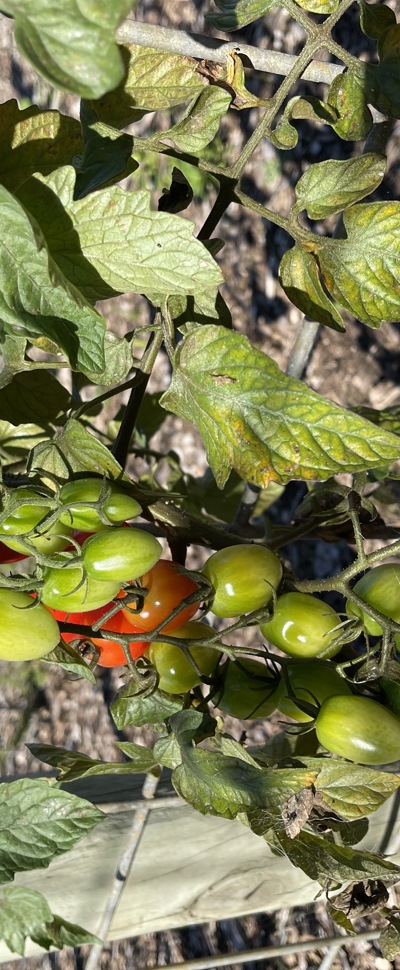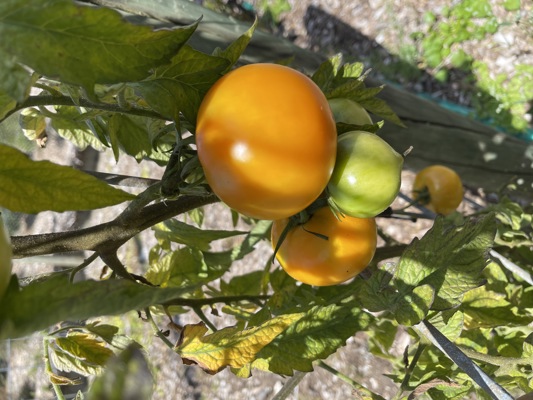
Tomato trial 2023-2024
Find out what tomatoes performed best in our summer trial
(NB: This tomato trial differs from an earlier trial carried out in 2016-2017.)
Tomatoes (Solanum lycopersicum) are a native plant from South America, in the same genus as several poisonous species such as deadly nightshade (Bateman, 1998). Despite being botanically a fruit, it is commonly eaten as a vegetable in a wide range of cuisines. Tomatoes are popularly grown across the world and can now be grown year-round with the use of greenhouses. Tomatoes typically require long sunshine hours, well-draining soil and warm temperatures. Auckland’s sub-tropical climate is ideal for growing tomatoes, as it is warm, with high rainfall and little frosts. However, the humid climate means that plants are highly susceptible to damage by various pests and diseases. The most common problems are blight, green fruit tops, mildew, nutrient deficiencies, and aphids.
Aims
Auckland Botanic Gardens (ABG) uses plant trials to test and identify plants that do well in Auckland conditions with desirable characteristics including little or no pests or diseases, long floral displays, productive harvest, uniform habits, and minimal maintenance requirements. The most recently completed trial at ABG was to find top performing Solanum lycopersicum selections that produce a healthy and edible crop that stays pest and disease free, whilst creating an attractive display.
Methods
Twelve cultivars of commercially available Solanum lycopersicum were sourced from Egmont Seeds and Kings Seeds, selected for their appearance, disease resistance and productivity. Tomatoes were sown in the Botanic Gardens nursery in September 2023, grown on and planted out in late October 2023 in the trials garden at ABG. Little maintenance of the plants was undertaken, except harvest, occasional watering and pinching of laterals. Monthly observations were made to assess the percentage of each plant affected by pests or diseases.
Results
All cultivars were fruiting by the beginning of January 2024, with the first harvests being from S. ‘Grape Sweet Hearts’, S. ‘Chocolate Sprinkles’ and S. ‘Gardener’s Delight’ (the three cherry varieties), the week of the 10th of January. All cultivars were harvested from by the 22nd of January. The largest harvests also came from the three cherry tomato varieties, as was expected (Table 1). The smallest harvests came from S. ‘Soprano’, ‘RuBee Prize’ and ‘Brandymaster Pink’. Harvests were undertaken once per week, with the largest harvests being in late January. By mid-March, harvests from all cultivars had started to dwindle, and the quality of the fruit being nearly inedible by the end of March. The final harvest was collected in the first week of April, though all of this fruit was composted due to the poor quality. This is likely a result of the earlier than usual cold weather. Plants had all but died off by mid-April and were removed at the end of April.
Upon maturity, the tallest cultivars were S. ‘Country Taste’, S. ‘Chef’s Choice Orange’, S. ‘Brandymaster Pink’ and S. ‘Grape Sweet Hearts’ (Table 1). There were significant differences in height between cultivars. S. ‘Soprano’ and S. ‘Gardener’s Delight’ were the smallest cultivars (and were also the unhealthiest cultivars). These two cultivars, as well as S. ‘Big Beef’ and S. ‘RuBee Prize’ all had dieback or mildew covering more than 60% of the plant from late Jan until April. Unfortunately, hybrid varieties (such as ‘Chef’s Choice Orange’ or Grape Sweet Hearts’ tended to be less prone to disease than the heirloom varieties (S. ‘Moneymaker’ and ‘Gardener’s Delight’). All plants had browning or yellowing leaves by early January, likely because of the warm Summer season and variations in watering (Table 1). More than half of the varieties had evidence of aphids or scale by March. The high proportion of pests and diseases on these plants significantly hampered their ability to produce fruit.
The tastiest cultivars (according to a group taste test) were S. ‘Grape Sweet Heart’s, ‘Chef’s Choice Orange’ and ‘Brandymaster Pink’ (Table 2). The healthiest cultivars, S. ‘Grape Sweet Hearts’, S. ‘Chocolate Sprinkles’, S. ‘Chef’s Choice Orange’ and S. ‘Country Taste’ were all cultivars that produced high quality fruit and are recommended to be grown in Auckland.
Conclusions
From this trial, we recommend S. lycopersicum ‘Grape Sweet Hearts’ and S. ‘Chef’s Choice Orange’ which rated 9/10 overall with consistent fruit, healthy plants and minimal maintenance. They also performed well in the taste evaluation. S. lycopersicum ‘Chocolate Sprinkles’, ‘Country Taste’ and ‘RuBee Goddess’ all rated 8/10 overall and are also recommended for an attractive display, with prolific and healthy fruits. Within most cultivars, there was some variability in fruit size and plant size. Based upon observation, we recommend planting these tomatoes in isolated pockets, rather than as a single bedding crop. Planting with companions or in mixed plantings will help to keep pest and disease levels low.
Table 1 Height (cm), pests and diseases, fruit size (cm), fruit weight (g) and quantity of fruit for twelve S. lycopersicum cultivars. Star performers are indicated with an asterisk (*).
| Solanum lycopersicum cultivar | Size (height in cm) |
Pests and disease (proportion of plant afflicted) | Fruit size (average) (diameter in cm) | Fruit weight (average in g) |
Quantity of fruit |
|
S. ‘Grape Sweet Hearts’ |
140 |
10% |
24 | 8 | 194 |
|
S. ‘Chocolate Sprinkles’ |
90 | 20% | 30 | 19 | 98 |
|
S. ‘Gardener’s Delight’ |
60 |
80%, scale, aphids |
25 | 12 | 166 |
|
S. ‘Soprano’ |
40 |
60% |
47 | 90 | 27 |
|
S. ‘Moneymaker’ |
135 |
40%, scale, aphids |
44 | 48 | 78 |
|
S. ‘Country Taste’ |
177 |
30%, scale, aphids |
57 | 100 | 47 |
|
S. ‘Chef’s Choice Orange’ |
168 |
10%, aphids |
66 | 155 | 75 |
|
S. ‘Big Beef’ |
127 |
60%, aphids, scale |
73 | 190 | 50 |
|
S. ‘Brandymaster Pink’ |
155 |
50%, aphids, scale |
78 | 205 | 26 |
|
S. ‘RuBee Goddess’ |
140 |
50% |
57 | 93 | 43 |
|
S. ‘RuBee Plus’ |
113 |
40%, aphids |
73 | 202 | 51 |
|
S. ‘RuBee Prize’ |
113 |
70%, aphids |
60 | 127 | 23 |
Table 2 Results of a group taste test for fruit from twelve S. lycopersicum cultivars.
| Solanum lycopersicum cultivar | Appearance | Taste |
|
S. ‘Grape Sweet Hearts’ |
Oblong cherry tomato, uniform in shape. |
Very sweet, typical cherry tomato flavour. Uniform in taste. |
|
S. ‘Chocolate Sprinkles’ |
Large, spherical cherry tomato. Interesting colour. |
More tart and watery than other cherry tomatoes. Uniform. |
|
S. ‘Gardener’s Delight’ |
Spherical shape, though some size variation. |
Sweet and tart flavour. Traditional cherry taste. Variable in flavour and appearance. |
|
S. ‘Soprano’ |
Traditional Roma shape, uniform in appearance. |
Generic tomato flavour, not sweet. Likely better for cooking. Floury. |
|
S. ‘Moneymaker’ |
Uniform in size and shape. |
Traditional tomato taste. Sweet and flavoursome, though variable. |
|
S. ‘Country Taste’ |
Uniform in size and shape. |
Sweet and tart, traditional tomato taste. Floury. |
|
S. ‘Chef’s Choice Orange’ |
Lovely round shape and unique orange/yellow colour. Uniform in appearance. |
Best taste. Tart with lots of flavour and sweetness. Perfect texture. |
|
S. ‘Big Beef’ |
Didn’t reach beefsteak size, significant size variation. |
Lacking flavour. Most floury of the large tomatoes, significant variation. |
|
S. ‘Brandymaster Pink’ |
Light pink colour, beefsteak size. Some inconsistency. |
Great strong tomato flavour. Perfect texture and taste. |
|
S. ‘RuBee Goddess’ |
Uniform in size and shape. |
Sweet with tartness. Ideal texture. |
|
S. ‘RuBee Plus’ |
Large size, some size variation. |
Delicious tart flavour. Soft and slightly grainy, though great flavour. Firm, very fleshy compared to liquid. |
|
S. ‘RuBee Prize’ |
Uniform in size and shape. |
Sweet. Unpleasant texture, very floury. |

S. ‘Chef’s Choice Orange’

S. ‘Grape Sweet Hearts’